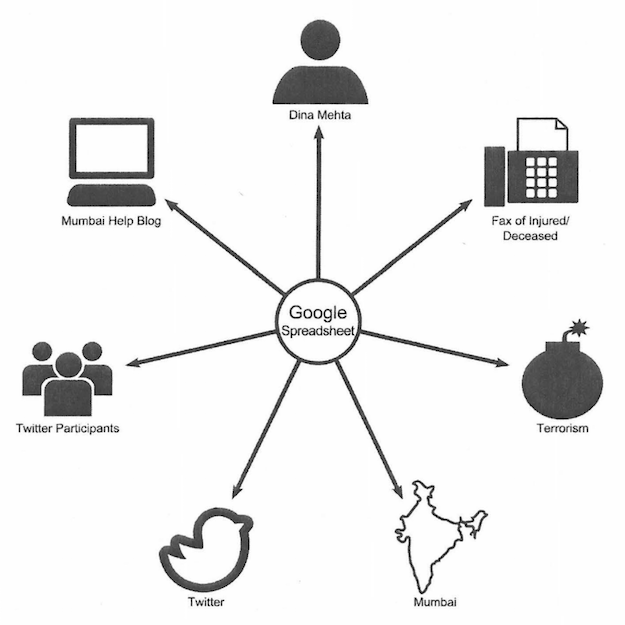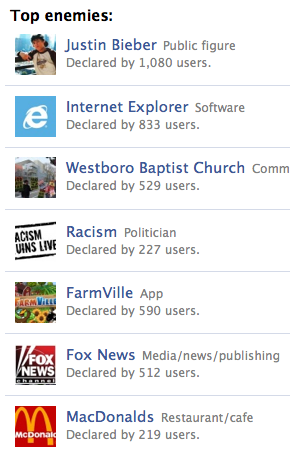
Figure 1: An actor-network diagram of the ad hoc network that formed in response to the 2008 Mumbai bombings (Potts, 2014, p. 95).
Where power seeks to force its will on others, rhetoric seeks the open persuasion of another. Writing networks, as a rhetorical activity, entails the expansion of rhetorical possibilities within—or in addition to—existing networks. When networks compete, the ability of one actor to impose his/her will on another via the network is diminished. In this way, writing networks is not only a means of countering the effects of network-making power, it can be a means of rendering the coercion inherent in this power susceptible to rhetorical competition. That is, network* writing, particularly writing networks, can counter the domination of network-making power by providing alternatives to that power.
Here I describe two metaphors that can be useful inventional resources for writing networks: programming, creating or imagining alternatives to existing networks so as to critique them, and switching, which enables unique network projects using the resources of existing networks.
Like other forms of network* writing, programming and switching create inventional possibilities for persuasion, directly engaging the logics of networked communication. For this reason, my goal here is not to describe specific writing tasks or genres that inform the creation of these networks. Rather, I argue that by bringing a new network into being—composing it within the context of other networks—switchers and programmers can both persuade and provide the grounds for other, networked forms of persuasion. Programming and switching both make use of texts and generate new ones, and these texts are important to communication in networked environments. However, to focus only on these texts without understanding the network forces that shape and produce them is to fail to understand the complexities of writing in networked environments. To this end, they can be useful metaphors for understanding the effects of networks on writing practices and providing opportunities for persuasion within those networks.
Programming networks
In network* power, programming is the act of setting the goals of a particular network (Castells, 2009, p. 45). Writers can create programs that reimagine the programmed foundations of existing networks, or they can create entirely new programs for networks that do not exist. PageRank was a program in this sense, one that imagined an alternative to existing search options with the addition of a simple algorithm.
Not all programs are algorithmic nor are they as impactful as PageRank has been; the process of imagining alternatives to existing networks can be accomplished in a number of ways. The essential practice is to identify the feature of the program one wishes to change and either supply or envision an alternative that enacts that change.
For example, whereas Google was once an upstart that challenged more dominant competitors, it is now, at the time of this writing, the most popular search engine in much of the Western world. A prominent feature of Google’s recent search efforts have been the use of personalization features in its searches, tailoring search results to the user (Vaidhyanathan, 2011, p. 183). To do so, however, the search engine must collect data on its users—most notably their history of searches. Because this practice can be successful, most other commercial search engines engage in it as well: The practice is nearly ubiquitous in web search. In addition to privacy concerns, this process can lead to what has been called a “filter bubble” (Pariser, 2011) where, as the search engine gathers ever more data on a person, that person will be increasingly less likely to see results that they might disagree with or that are unlike their search histories. Such contrary views are effectively filtered out of their searches, encasing them in a bubble where their ideas are never challenged.
The search engine DuckDuckGo operates according to a different program: It does not profile its users search habits and shows the same search results to all users. In this way, it offers an alternative to search engines that collect user data to personalize search results. Users can easily compare search results from DuckDuckGo to those from Google or other search engines to see if they prefer them or to simply measure the effects of search personalization on their queries. In this way, DuckDuckGo provides an alternative search network that is not impacted by the dominant trend of search personalization.

Figure 2: Screen capture from EnemyGraph showing a users top enemies. (Terry, 2012)
Similarly, the Facebook app EnemyGraph provided an alternative to the Friends list on social media site Facebook, allowing users to identify and list enemies (Terry, 2012). Where social networking sites allow users to articulate connections with other users (boyd & Ellison, 2007), those connections are almost always defined positively, exemplified by Facebook’s Likes and Friends. The creators of EnemyGraph described it as “a critique [of] the social philosophy of Facebook” (Terry, 2012, n.p.), but rather than taking the form of an essay or other text, it reimagined the program of the site, allowing users to experience the project in a networked form.
DuckDuckGo and EnemyGraph are computer programs, but the programs of writing networks do not need to be software. Network programs take many forms, including the establishment of rules and guidelines. Programs can be any set of rules that govern the interactions of actors on a network, such as the rules and community guidelines of Wikipedia (Sanger, 2006, pp. 320–321). When combined with the expandability and reconfigurability of the Web, these programs can have surprising and unique results, and the goal of writing networks is to account for and reimagine the outcomes of these networks.
Switching networks
Switching enables the generation of unique arrangements of existing network resources, using those resources to create new structures that address the shortcomings of existing networks. Because it makes use of existing networks, switching is useful in situations where creating a new network is vital to a rhetorical goal. But, the resource needs necessary to create that network independently of other networks are either prohibitive or impossible to satisfy, because of a time constraint, for example.
Switching is inherently collaborative. Not only does it depend on existing resources, it requires the participation of human actors. In her case studies of social media use in response to traumatic events like the 2008 Mumbai terrorist attacks, Liza Potts (2014) showed how engaged actors were able to cobble together ad-hoc networks to serve communication needs that could not be effectively met by existing networks (Fig. 1). One such network combined a number of network resources to provide Mumbai residents with accurate lists of those killed or injured in the attacks. The success of this network was dependent upon the coordination of human actors who were able to verify and distribute information.
Similarly, in Larry Sanger’s (2006) description of the formation of Wikipedia, he outlined the role of technologies like the wiki, but also the community of Wikipedia users in the creation of the encyclopedia. An earlier online encyclopedia project, Nupedia, had failed precisely because it was unable to generate the necessary level of coordination with users who were interested in adding articles. The combination of the wiki, a technological interface that allowed for easy editing, and the opening up of the community to allow for a larger and more engaged pool of editors was key to the success of the project.
In these case studies, neither Potts nor Sanger addressed switching. Yet both cases involve networked interventions above the level of individual texts that allowed for significant new rhetorical responses to existing networks. Potts specifically identified the Mumbai network—along with the other case studies in her book—as sites of critique of existing networks, showcasing the needs of individuals in the wake of disasters and illustrating the limitations of existing networked resources to satisfy those needs. Similarly, Wikipedia fundamentally changed the idea of the encyclopedia, adapting it—in style and content—to the needs of the network.
Writing networks
Because of the significance of communication networks, programming and switching are essential skills for writing and rhetoric on networks. Although instructors and practitioners still must focus on networked writing and network writing, we must turn our focus to writing networks using the metaphors of programming and switching to guide our practices.
Instructors can use the examples above as guides for creating assignments that make use of these concepts as a means of generating networks. For example, a writer could analyze an existing switching network as Potts did, creating her own diagrams of those networks (Fig. 1) and analyzing the texts the network produces. Alternatively, they could imagine new networks created by combining existing network resources, generating both descriptions of those networks and sample texts enabled by those networks.
Similarly, writers could explore the use of programming in networks by devising and enacting the programs of networks. These programs could take the form of algorithms and be enacted in software or as thought-experiments. As with switching, the creators of these programs could experiment with generating the texts that these networks would create.
Like the taxonomy of network* writing, switching and programming are not necessarily mutually exclusive. The two work in tandem to generate networks. But they can be used separately to imagine the potential for rhetorical action in the domain of network* power.
